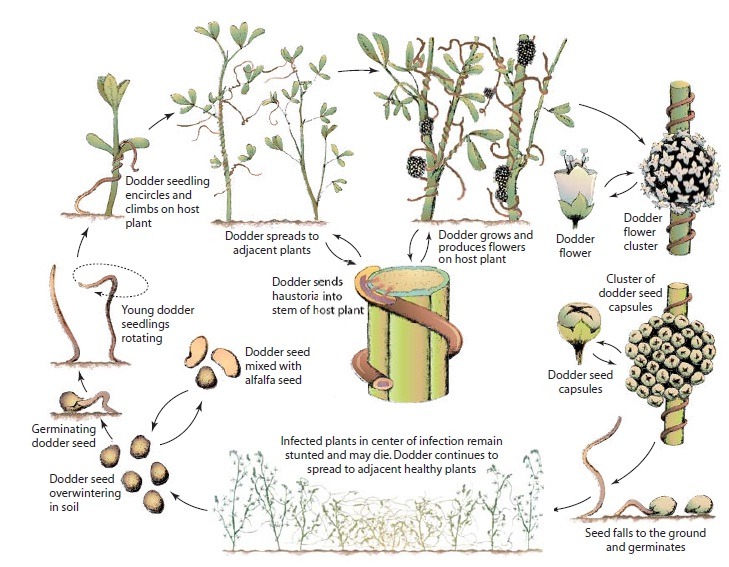Dodder
Introduction
- Dodder is parasitic higher plants belongs to cuscuta spp.
- Dodder is widely distributed in the Americas, Europe, Africa, southern Asia, and Australia.
- Crops that suffer losses from dodder includes onions, sugar beets, several ornamentals, and potatoes.
- Dodder affects the growth and yield of infected plants.
- Dodder may also serve as a bridge for transmission of viruses from virus infected to virus-free plants.
- Losses range from slight to complete destruction of the crop in the infested areas.

- Dodder is a slender, twining plant. The stem is tough, curling, threadlike, and leafless, bearing only minute scales in place of leaves.
- The stem is usually yellowish or orange in color, sometimes tinged with red or purple; sometimes it is almost white. Clusters of tiny flowers occur on the stem from early June until frost.
- Gray to brown seeds are produced in abundance by the flowers and mature within a few weeks after bloom.
Development of Disease
Dodder seed overwinters in infested fields or is mixed with the seed of crop plants. During the growing season the seed germinates and produces a slender yellowish shoot but no roots. This leafless shoot rotates as though in search of a host. If no contact with a susceptible plant is made, the stem falls to the ground, where it lies dormant for a few weeks and then dies.
Dodder stems in contact with a susceptible host encircle the host plant, send haustoria into it, and begin to climb the plant. The haustoria penetrate the stem or leaf and reach into the vascular tissues, from which they absorb foodstuffs and water.

Soon after contact with the host is established, the base of the dodder shrivels and dries so that the dodder loses all connection with the ground and becomes completely dependent on the host for nutrients and water. The dodder continues to grow and expand, and its twisting tips reach out and attack adjacent plants, forming patches of infected plants. The growth of infected plants is suppressed and they may finally die.
In the meantime, the dodder plant has developed flowers and produced seeds. The seeds fall to the ground where they either germinate immediately or remain dormant until the next season. The seed may be spread to nearby areas by animals, water, and equipment, and over long distances by contaminated crop seed.
Symptoms
- Orange or yellow vine strands grow and entwine around the stems and the other above ground parts of the plants.
- The growing tips reach out and attack adjacent plants until a circle of infestation, up to 10 feet in diameter, is formed by a single dodder plant.
- At the time of late spring and in the summer, dodder produces massed clusters of white, pink, or yellowish flowers, which soon form seed.
- The infected host plants become weakened by the parasite, their vigor declines, and they produce poor yields.
- Many are smothered and may be killed by the parasite.
- As the infection spreads, several patches coalesce and form large areas covered by the yellowish vine of the parasite.
Dodder Control
- Dodder is control by preventing it to introduce into a field by the use of dodder free seed, by cleaning equipment before moving it from dodder infected fields to new areas or fields, and by reduce the movement of any kind of domestic animals from infectedfields to dodder free fields.
- If dodder is present in the field, herbicides should be sprayed early in the season.
- These treatment, or cutting or burning of patches, kills both the dodder and the host plants but restrict dodder from spreading and also restrict producing seeds.
- At the point when dodder infestations are already spread in a field, dodder can be controlled by frequent tillage, flaming, and use of herbicides that kill the dodder plant on its germination from the seed yet before it becomes attached or joined to the host.
Reference and Sources
- 1% – http://www.fao.org/3/ai387e/ai387e05.htm
- 1% – https://quizlet.com/170618264/plant-pathology-test-4-review-fall-2016-prof-garces-valencia-flash-cards/
- 5% – https://www.sciencedirect.com/topics/immunology-and-microbiology/cuscuta
- 1% – https://pddc.wisc.edu/category/general-horticulture-weeds/page/5/
Also Read:
- Microbial Fuel Cells
- Antimicrobial activity of Mimosa pudica l
- what is microbiology?
- How to Build a Microorganism?
- Overview of Viroids, Satellites and prions
- Measurements of microbial growth
- Difference between Prokaryotes and Eukaryotes
- Animal and plant viruses, prions, and viroids
- Bacteriophage: characteristics and replication of lytic and lysogenic cycle
- Virus: Introduction, Properties and Classifications
- Algae : occurrence, classification and economic importance
- Cyanobacteria: occurrence, morphology, structure, reproduction
- Fungi: Distribution, Morphology, Reproduction, Classification
